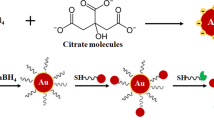Abstract
Objective: Nanosized materials of gadolinium oxide can provide high-contrast enhancement in magnetic resonance imaging (MRI). The objective of the present study was to investigate proton relaxation enhancement by ultrasmall (5 to 10 nm) Gd2O3 nanocrystals.
Materials and methods: Gd2O3 nanocrystals were synthesized by a colloidal method and capped with diethylene glycol (DEG). The oxidation state of Gd2O3 was confirmed by X-ray photoelectron spectroscopy. Proton relaxation times were measured with a 1.5-T MRI scanner. The measurements were performed in aqueous solutions and cell culture medium (RPMI).
Results: Results showed a considerable relaxivity increase for the Gd2O3–DEG particles compared to Gd-DTPA. Both T 1 and T 2 relaxivities in the presence of Gd2O3–DEG particles were approximately twice the corresponding values for Gd–DTPA in aqueous solution and even larger in RPMI. Higher signal intensity at low concentrations was predicted for the nanoparticle solutions, using experimental data to simulate a T1-weighted spin echo sequence.
Conclusion: The study indicates the possibility of obtaining at least doubled relaxivity compared to Gd–DTPA using Gd2O3–DEG nanocrystals as contrast agent. The high T 1 relaxation rate at low concentrations of Gd2O3 nanoparticles is very promising for future studies of contrast agents based on gadolinium-containing nanocrystals.
Similar content being viewed by others
References
Jaffer FA, Weissleder R (2005) Molecular imaging in the clinical arena. J Am Med Assoc 293:855–862
Gillies RJ (2002) In vivo molecular imaging. J Cell Biochem 39:231–238
Dijkhuizen RM, Nicolay K (2003) Magnetic resonance imaging in experimental brain model of brain disorders. J Cerebr Blood Flow Metabol 23:1383–1402
Wickline SA, Lanza GM (2002) Molecular imaging, targeted therapeutics, and nanoscience. J Cell Biochem S39:90–97
McDonald MA, Watkin KL (2004) Investigation into the structure and magnetic properties of dextran small particulate gadolinium oxide nanoparticles. In: 12th scientific meeting and exhibition, International Society for Magnetic Resonance in Medicine (ISMRM), Kyoto, Japan, p 1718
McDonald MA, Watkin KL (2003) Small particulate gadolinium oxide and gadolinium oxide albumin microspheres as multimodal contrast and therapeutic agents. Invest Radiol 38:305–310
Söderlind F, Pedersen H, Petoral RM Jr, Käll P-O, Uvdal K (2005) Synthesis and characterisation of Gd 2 O 3 nanocrystals functionalised by organic acids. J Colloid Interface Sci 288:140–148
Feldmann C (2003) Polyol-mediated synthesis of nanoscale functional materials. Adv Funct Mater 13:101–107
Bazzi R, Flores-Gonzalez MA, Louis C, Lebbou K, Durjardin C, Brenier A, Zhang W, Tillement O, Bernstein E, Perriat P (2003) Synthesis and luminescent properties of sub-5-nm lanthanide oxides nanoparticles. J Luminescence 102:445–450
Bazzi R, Flores C, Louis C, Lebbou K, Zhang W, Durjardin C, Roux S, Mercier B, Ledoux G, Bernstein E, Perriat P, Tillement O (2004) Synthesis and properties of europium-based phosphors on the nanometer scale: Eu2O3, Gd2O3:Eu, and Y2O3:Eu. J Colloid Interface Sci 273:191–197
In den Kleef JJE, Cuppen JJM (1987) RLSQ: T1, T2 and RHO calculations, combining ratios and least squares. Magn Res Med 5:513–524
Raiser D, Deville JP (1991) Study of XPS photoemission of some gadolinium compounds. J Electron Spectrosc 57:91–97
Pedersen H, Söderlind F, Petoral RM, Uvdal K, Käll PO, Ojamäe L (2005) Surface interactions betweenY(2)O(3) nanocrystals and organic molecules – study. Surf Sci 592:124–140
Hendrick RE, Haacke EM (1993) Basic physics of MR contrast agents and maximization of image contrast. J Magn Res Imag 3:137–148
Bloembergen N, Purcell EM, Pound RV (1948) Relaxation effects in nuclear magnetic resonance absorption. Phys Rev 73:679–712
Nelson TR, Tung SM (1987) Temperature dependence of proton relaxation times in vitro. Magn Reson Imag 5:189–199
Stanisz GJ, Henkelman RM (2000) Gd–DTPA relaxivity depends on macromolecular content. Magn Red Med 44:665–667
Lauffer RB (1987) Paramagnetic metal complexes as water proton relaxation agents for NMR imaging: theory and design. Chem Rev 87:901–927
Aime S, Barge A, Botta M, Parker D, De Sousa AS (1997) Prototropic vs whole water exchange contribution to the solvent relaxation enhancement in the aqueous solution of a cationic Gd3+ macrocyclic complex. J Am Chem Soc 119:4767–4768
Aime S, Botta M, Fasano M, Paoletti S, Terreno E (1997) Relaxometric determination of the exchange rate of the coordinated water protons in a Neutral GdIII chelate. Chem Eur J 3:1499–1504
Botta M, Aime S, Barge A, Bobba G, Dickins RS, Parker D, Terreno E (2003) Ternary complexes between cationic GdIII chelates and anionic metabolites an aqueous solution: an NMR relaxometric study. Chem Eur J 9:2102–2109
Lowe MP, Parker D, Reany O, Aime S, Botta M, Castellano G, Gianolio E, Pagliarin R (2001) pH-dependent modulation of relaxivity and luminescence in macrocyclic gadolinium and europium complexes based on reversible intramolecular sulfonamide ligation. J Am Chem Soc 123:7601–7609
Reynolds CH, Annan N, Beshah K, Huber JH, Shaber SH, Lenkinski RE, Wortman JA (2000) Gadolinium-loaded nanoparticles: new contrast agents for magnetic resonance imaging. J Am Chem Soc 122:8940–8945
Cacheris WP, Quay SC, Rocklage SM (1990) The relationship between thermodynamics and the toxicity of gadolinium complexes. Magn Res Imag 8:467–481
Bruemmel Y, Chan CP, Renneberg R, Thuenemann A, Seydack M (2004) On the influence of different surfaces in nano- and submicrometer particle based fluorescence immunoassays. Langmuir 20:9371–9379
Nichkova M, Dosev D, Gee SJ, Hammock BD, Kennedy IM (2005) Microarray immunoassay for phenoxybenzoic acid using polymer encapsulated Eu:Gd2O3 nanoparticles as fluorescent labels. Anal Chem 77:6864–6873
Lebbou K, Perriat P, Tillement O (2005) Recent progress on elaboration of undoped and doped Y2O3, Gd2O3 rare earth nano-oxide. J Nanosci Nanotechnol 5:1448–1454
Author information
Authors and Affiliations
Corresponding author
Rights and permissions
About this article
Cite this article
Engström, M., Klasson, A., Pedersen, H. et al. High proton relaxivity for gadolinium oxide nanoparticles. Magn Reson Mater Phy 19, 180–186 (2006). https://doi.org/10.1007/s10334-006-0039-x
Received:
Revised:
Accepted:
Published:
Issue Date:
DOI: https://doi.org/10.1007/s10334-006-0039-x




